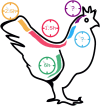The vertebrate Embryo Clock: Common players dancing to a different beat
- PMID: 36036002
- PMCID: PMC9403190
- DOI: 10.3389/fcell.2022.944016
The vertebrate Embryo Clock: Common players dancing to a different beat
Abstract
Vertebrate embryo somitogenesis is the earliest morphological manifestation of the characteristic patterned structure of the adult axial skeleton. Pairs of somites flanking the neural tube are formed periodically during early development, and the molecular mechanisms in temporal control of this early patterning event have been thoroughly studied. The discovery of a molecular Embryo Clock (EC) underlying the periodicity of somite formation shed light on the importance of gene expression dynamics for pattern formation. The EC is now known to be present in all vertebrate organisms studied and this mechanism was also described in limb development and stem cell differentiation. An outstanding question, however, remains unanswered: what sets the different EC paces observed in different organisms and tissues? This review aims to summarize the available knowledge regarding the pace of the EC, its regulation and experimental manipulation and to expose new questions that might help shed light on what is still to unveil.
Keywords: HES; embryo clock; negative feedback regulation; notch signalling; somitogenesis; temporal control.
Copyright © 2022 Carraco, Martins-Jesus and Andrade.
Conflict of interest statement
The authors declare that the research was conducted in the absence of any commercial or financial relationships that could be construed as a potential conflict of interest.
Figures




Similar articles
-
Chick Hairy1 protein interacts with Sap18, a component of the Sin3/HDAC transcriptional repressor complex.BMC Dev Biol. 2007 Jul 10;7:83. doi: 10.1186/1471-213X-7-83. BMC Dev Biol. 2007. PMID: 17623094 Free PMC article.
-
Mechanisms of vertebrate embryo segmentation: Common themes in trunk and limb development.Semin Cell Dev Biol. 2016 Jan;49:125-34. doi: 10.1016/j.semcdb.2016.01.010. Epub 2016 Jan 19. Semin Cell Dev Biol. 2016. PMID: 26805722 Review.
-
A clock-work somite.Bioessays. 2000 Jan;22(1):72-83. doi: 10.1002/(SICI)1521-1878(200001)22:1<72::AID-BIES12>3.0.CO;2-S. Bioessays. 2000. PMID: 10649293 Review.
-
Segmentation of the paraxial mesoderm and vertebrate somitogenesis.Curr Top Dev Biol. 2000;47:81-105. doi: 10.1016/s0070-2153(08)60722-x. Curr Top Dev Biol. 2000. PMID: 10595302 Review.
-
Regulation of paraxis expression and somite formation by ectoderm- and neural tube-derived signals.Dev Biol. 1997 May 15;185(2):229-43. doi: 10.1006/dbio.1997.8561. Dev Biol. 1997. PMID: 9187085
Cited by
-
Spatio-temporal dynamics of early somite segmentation in the chicken embryo.PLoS One. 2024 Apr 18;19(4):e0297853. doi: 10.1371/journal.pone.0297853. eCollection 2024. PLoS One. 2024. PMID: 38635504 Free PMC article.
-
Simplifications and approximations in a single-gene circuit modeling.Sci Rep. 2024 May 31;14(1):12498. doi: 10.1038/s41598-024-63265-8. Sci Rep. 2024. PMID: 38822072 Free PMC article.
-
Species-specific roles of the Notch ligands, receptors, and targets orchestrating the signaling landscape of the segmentation clock.Front Cell Dev Biol. 2024 Jan 29;11:1327227. doi: 10.3389/fcell.2023.1327227. eCollection 2023. Front Cell Dev Biol. 2024. PMID: 38348091 Free PMC article. Review.
-
Rules of teeth development align microevolution with macroevolution in extant and extinct primates.Nat Ecol Evol. 2023 Oct;7(10):1729-1739. doi: 10.1038/s41559-023-02167-w. Epub 2023 Aug 31. Nat Ecol Evol. 2023. PMID: 37652997
-
Sex diversity in the 21st century: Concepts, frameworks, and approaches for the future of neuroendocrinology.Horm Behav. 2024 Jan;157:105445. doi: 10.1016/j.yhbeh.2023.105445. Epub 2023 Nov 17. Horm Behav. 2024. PMID: 37979209 Free PMC article.
References
Publication types
LinkOut - more resources
Full Text Sources

